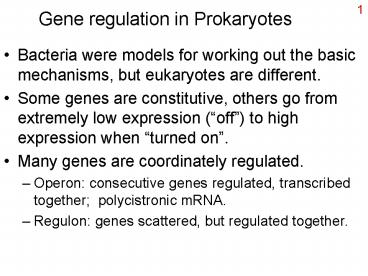Gene regulation in Prokaryotes - PowerPoint PPT Presentation
Title:
Gene regulation in Prokaryotes
Description:
Gene regulation in Prokaryotes Bacteria were models for working out the basic mechanisms, but eukaryotes are different. Some genes are constitutive, others go from ... – PowerPoint PPT presentation
Number of Views:446
Avg rating:3.0/5.0
Title: Gene regulation in Prokaryotes
1
Gene regulation in Prokaryotes
- Bacteria were models for working out the basic
mechanisms, but eukaryotes are different. - Some genes are constitutive, others go from
extremely low expression (off) to high
expression when turned on. - Many genes are coordinately regulated.
- Operon consecutive genes regulated, transcribed
together polycistronic mRNA. - Regulon genes scattered, but regulated together.
2
Rationale for Operon
- Many metabolic pathways require several enzymes
working together. - In bacteria, transcription of a group of genes is
turned on simultaneously, a single mRNA is made,
so all the enzymes needed can be produced at once.
http//galactosaemia.com.hosting.domaindirect.com/
images/metabolic-pathway.gif
3
Proteins change shape
When a small molecule binds to the protein, it
changes shape. If this is a DNA-binding protein,
the new shape may cause it to attach better to
the DNA, or fall off the DNA.
http//omega.dawsoncollege.qc.ca/ray/genereg/opero
n3.JPG
4
Definitions concerning operon regulation
- Control can be Positive or Negative
- Positive control means a protein binds to the DNA
which increases transcription. - Negative control means a protein binds to the DNA
which decreases transcription. - Induction
- Process in which genes normally off get turned
on. - Usually associated with catabolic genes.
- Repression
- Genes normally on get turned off.
- Usually associated with anabolic genes.
5
Structure of an Operon
- Structural genes actual genes being regulated.
- Promoter region site for RNA polymerase to bind,
begin transcription. - Operator region site where regulatory protein
binds. - Regulatory protein gene need not be in the same
area as the operon. Protein binds to DNA.
www.cat.cc.md.us
6
Animations
- Look up Animations showing the effects of the
lactose repressor on the lac operon. - As with translation, details will vary. For
example, the lactose repressor protein is a
tetramer. How many sites depict it this way? - Be wary of oversimplification.
7
The Lactose Operon
- The model system for prokaryotic gene regulation,
worked out by Jacob and Monod, France, 1960. - The setting E. coli has the genes for using
lactose (milk sugar), but seldom sees it. Genes
are OFF. - Repressor protein (product of lac I gene) is
bound to the operator, preventing transcription
by RNA polymerase.
Green repressor protein Purple RNA polymerase
8
Lactose operon-2
- When lactose does appear, E. coli wants to use
it. Lactose binds to repressor, causing shape
change repressor falls off DNA, allows
unhindered transcription by RNA polymerase.
Translation of mRNA results in enzymes needed to
use lactose.
9
Lactose operon definitions
- Control is Negative
- When repressor protein is bound to the DNA,
transcription is shut off. - This operon is inducible
- Lactose is normally not available as a carbon
source genes are shut off - In bacteria, many similar operons exist for using
other organic molecules. - Proteins for transporting the sugar, breaking it
down are produced.
10
Repressible operons
- Operon codes for enzymes that make a needed amino
acid (for example) genes are on. - Repressor protein is NOT attached to DNA
- Transcription of genes for enzymes needed to make
amino acid is occurring. - The change amino acid is now available in the
culture medium. Enzymes normally needed for
making it are no longer needed. - Amino acid, now abundant in cell, binds to
repressor protein which changes shape, causing it
to BIND to operator region of DNA. Transcription
is stopped. - This is also Negative regulation (protein DNA
off).
11
Repression picture
Transcription by RNA polymerase prevented.
12
Regulation can be fine tuned
The more of the amino acid present in the cell,
the more repressor-amino acid complex is formed
the more likely that transcription will be
prevented.
13
Positive regulation
- Binding of a regulatory protein to the DNA
increases (turns on) transcription. - More common in eukaryotes.
- Prokaryotic example the CAP-cAMP system
- Catabolite-activating Protein
- cAMP ATP derivative, acts as signal molecule
- When CAP binds to cAMP, creates a complex that
binds to DNA, turning ON transcription. - Whether there is enough cAMP in the cell to
combine with CAP depends on glucose conc.
14
Positive regulation-2
- Glucose is preferred nutrient source
- Other sugars (lactose, etc.) are not.
- Glucose inhibits activity of adenylate cyclase,
the enzyme that makes cAMP from ATP. - When glucose is high, cAMP is low, less cAMP is
available to bind to CAP. - CAP is free, doesnt bind to DNA, genes not on.
- When glucose is low, cAMP is high
- Lots of cAMP, so CAP-cAMP forms, genes on.
- Works in conjunction with induction.
15
Cartoon of Positive Regulation
16
Attenuation fine tuning repression
- Attenuation occurs in prokaryotic repressible
operons. Happens when transcription is on. - Regulation at the level of translation
- Several things important
- Depends on base-pairing between complementary
sequences of mRNA - Requires simultaneous transcription/translation
- Involves delays in progression of ribosomes on
mRNA
17
Mechanism of attenuation- tryp operon
18
Mech. of attenuation -2
19
Attenuation-3

